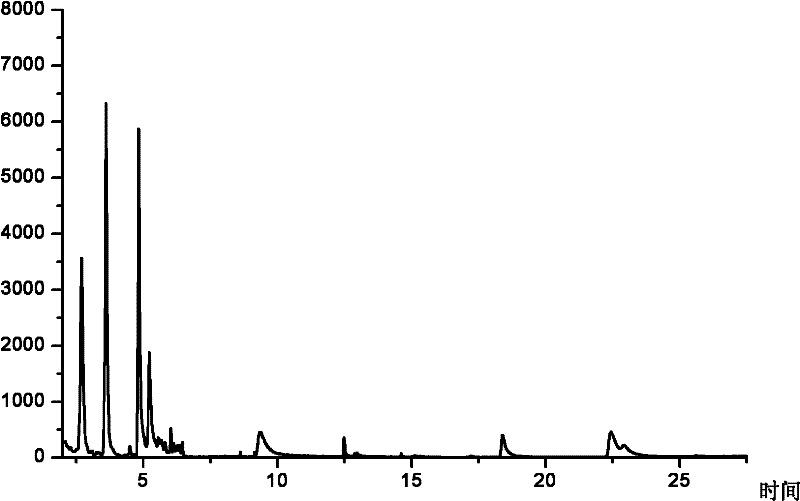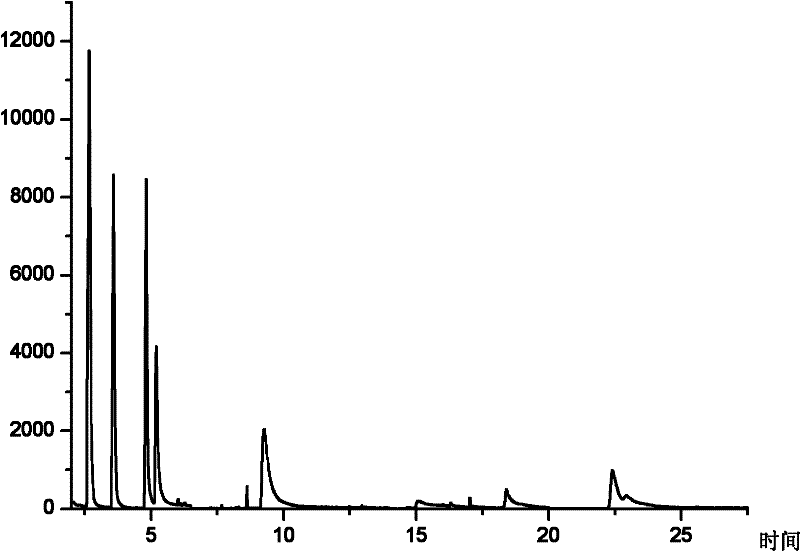Method for measuring aromatic amine in plasticine
A determination method and plasticine technology, which are applied to measurement devices, preparation of test samples, instruments, etc., can solve problems such as inappropriate detection of aromatic amines in crayons, and achieve the effect of avoiding matrix interference and being easy to popularize.
- Summary
- Abstract
- Description
- Claims
- Application Information
AI Technical Summary
Problems solved by technology
Method used
Image
Examples
Embodiment 1
[0023] 1. Determination method of aromatic amine in plasticine
[0024] (1) Plasticine sample processing
[0025] (1) Take a certain quality of plasticine, cut it into small pieces with a clean blade, and ultrasonically extract the small pieces of plasticine with methanol twice to obtain an extract, and add methanol according to the ratio of 1 gram of plasticine / 40ml of methanol;
[0026] (2) After centrifuging the extract, collect the clarified solution into a heart-shaped bottle, and use a rotary evaporator to evaporate until nearly dry, and then dry it with a slow nitrogen flow;
[0027] (3) Add 200mg / ml sodium dithionite solution (200mg / ml sodium dithionite solution prepared with pH6 citrate buffer solution as solvent) to the chicken heart bottle, add dithionite according to the ratio of 1 gram of plasticine / 0.6 gram of sodium dithionite Sodium disulfite solution, reacted at 70°C for 30 minutes, and cooled to room temperature after the reaction;
[0028] (4) Add a certai...
Embodiment 2
[0058] 1. Determination method of aromatic amine in plasticine
[0059] (1) Plasticine sample processing
[0060] (1) Take a certain quality of plasticine, cut it into small pieces with a clean blade, and extract the small piece of plasticine with acetonitrile ultrasonically twice to obtain an extract, and add acetonitrile according to the ratio of 1 gram of plasticine / 20ml of acetonitrile;
[0061] (2) After centrifuging the extract, collect the clarified solution into a heart-shaped bottle, and use a rotary evaporator to evaporate until nearly dry, and then dry it with a slow nitrogen flow;
[0062] (3) Add 200mg / ml sodium dithionite solution (200mg / ml sodium dithionite solution prepared with pH6 citrate buffer solution as solvent) to the chicken heart bottle, add dithionite according to the ratio of 1 gram of plasticine / 0.4 gram of sodium dithionite Sodium disulfite solution, reacted at 80°C for 20 minutes, and cooled to room temperature after the reaction;
[0063] (4) A...
Embodiment 3
[0075] 1. Determination method of aromatic amine in plasticine
[0076] (1) Plasticine sample processing
[0077] (1) Weigh a certain quality of plasticine, cut it into small pieces with a clean blade, and ultrasonically extract the small pieces of plasticine with isopropanol twice to obtain the extract, add isopropanol according to the ratio of 1 gram of plasticine / 60ml of isopropanol propanol;
[0078] (2) After centrifuging the extract, collect the clarified solution into a heart-shaped bottle, and use a rotary evaporator to evaporate it to nearly dryness, and then blow it dry with a slow nitrogen flow.
[0079] (3) Add 200mg / ml sodium dithionite solution (200mg / ml sodium dithionite solution prepared with pH 6 citrate buffer solution as solvent) into the chicken heart bottle, and add dithionite according to the ratio of 1 gram of plasticine / 1 gram of sodium dithionite. Sodium disulfite solution, reacted at 60°C for 40 minutes, and cooled to room temperature after the reac...
PUM
| Property | Measurement | Unit |
|---|---|---|
| ionization potential | aaaaa | aaaaa |
Abstract
Description
Claims
Application Information
 Login to View More
Login to View More - R&D
- Intellectual Property
- Life Sciences
- Materials
- Tech Scout
- Unparalleled Data Quality
- Higher Quality Content
- 60% Fewer Hallucinations
Browse by: Latest US Patents, China's latest patents, Technical Efficacy Thesaurus, Application Domain, Technology Topic, Popular Technical Reports.
© 2025 PatSnap. All rights reserved.Legal|Privacy policy|Modern Slavery Act Transparency Statement|Sitemap|About US| Contact US: help@patsnap.com



